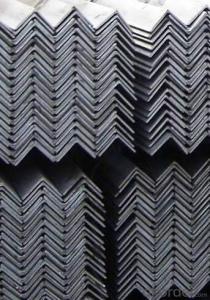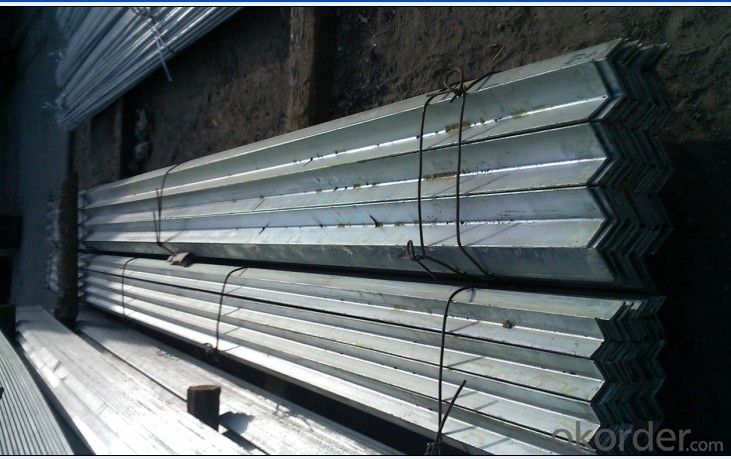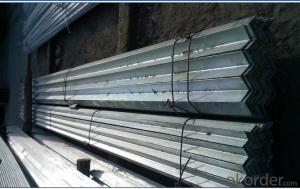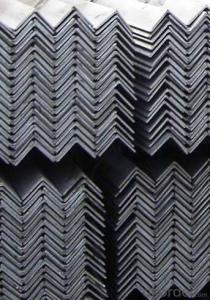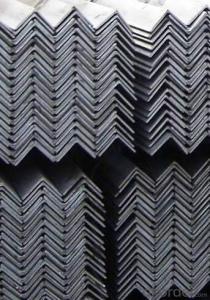BS STANDARD HIGH QUALITY HOT ROLLED ANGLE
- Loading Port:
- Tianjin
- Payment Terms:
- TT OR LC
- Min Order Qty:
- 50 m.t.
- Supply Capability:
- 100000 m.t./month
OKorder Service Pledge
OKorder Financial Service
You Might Also Like
Product Description
Appearance: Black
Technique: Slitting hot rolled steel coil
Grade: Q235, Q195,A36 SS400 S235jr.St37-2
Standard: AISI,GB,DIN,ASTM,EN,JIS
Length: 6m, 9m, 12m or as your requirement.
Width: 10mm-1010mm
Thickness: 1.5mm-20mm
Place of origin: Tianjin China (Mainland)
Packaging Details: In bundles for exporting and sea worthy
Delivery Detail: Within 15-35 days after receiving L/C or deposite T/T


General specification as below:
Flat Bar Specification | |||
Width (mm) | Thickness (mm) | Length (m) | Theoretical Weight (kg/m) |
20 | 2.0 | 6/9/12 | 0.31 |
20 | 2.5 | 6/9/12 | 0.39 |
20 | 2.75 | 6/9/12 | 0.43 |
25 | 2.5 | 6/9/12 | 0.49 |
25 | 3.75 | 6/9/12 | 0.74 |
30 | 2.5 | 6/9/12 | 0.59 |
30 | 3.5 | 6/9/12 | 0.82 |
30 | 9.75 | 6/9/12 | 2.30 |
40 | 3.5 | 6/9/12 | 1.10 |
40 | 4.75 | 6/9/12 | 1.50 |
40 | 11.75 | 6/9/12 | 3.69 |
50 | 2.75 | 6/9/12 | 1.08 |
50 | 4.5 | 6/9/12 | 1.77 |
50 | 9.75 | 6/9/12 | 3.83 |
60 | 5.5 | 6/9/12 | 2.60 |
60 | 7.5 | 6/9/12 | 3.53 |
60 | 11.5 | 6/9/12 | 5.42 |
80 | 5.5 | 6/9/12 | 3.45 |
80 | 7.5 | 6/9/12 | 4.71 |
80 | 11.75 | 6/9/12 | 7.38 |
100 | 3.25 | 6/9/12 | 2.55 |
100 | 4.75 | 6/9/12 | 3.73 |
100 | 7.5 | 6/9/12 | 5.89 |
120 | 9.75 | 6/9/12 | 9.18 |
120 | 11.75 | 6/9/12 | 11.07 |
150 | 9.75 | 6/9/12 | 11.48 |
150 | 11.5 | 6/9/12 | 13.54 |
150 | 13.5 | 6/9/12 | 15.90 |
160 | 11.75 | 6/9/12 | 14.76 |
200 | 9.5 | 6/9/12 | 14.92 |
250 | 5.75 | 6/9/12 | 11.28 |
340 | 7.75 | 6/9/12 | 20.68 |
Products Advantages
1. high quality competitive price and Accurate in size
2. high dimensional accuracy
3. Guaranteed raw material
4.high utilization rate of material
5.convenient in construction, saving much time and labor
6. high mechanical strength
Application: Widely used for construction, Ship building, Machinery manufacturing ,steel structure,agriculture and steel grating.
- Q: What are the different methods of surface galvanizing for steel angles?
- Steel angles can be surface galvanized using various methods, each with its own benefits and uses. Here are some commonly employed techniques: 1. Hot-dip galvanizing: The most widely utilized method involves immersing steel angles in molten zinc, forming a strong bond with the surface. This process offers exceptional corrosion protection and durability, making it suitable for a wide range of applications. 2. Electro-galvanizing: This method involves electrodepositing a thin layer of zinc onto the steel angle's surface. It is a controlled process that provides a smoother and more even coating. Electro-galvanizing is often used for decorative purposes or when a thinner coating is sufficient. 3. Sherardizing: This method entails coating the steel angles with a mixture of zinc dust and proprietary filler materials, such as aluminum or iron powder. The coated angles are then heated in a furnace, causing zinc to diffuse into the steel's surface, forming a durable alloy layer. Sherardizing is ideal for applications requiring high resistance to wear and abrasion. 4. Mechanical galvanizing: Also known as centrifuge galvanizing, this method involves tumbling steel angles in a drum or barrel with zinc powder and glass beads. The tumbling action helps zinc powder adhere to the surface, creating a protective coating. Mechanical galvanizing is commonly used for small or intricate parts that are challenging to galvanize with other methods. 5. Zinc-rich paint: Although not a conventional galvanizing method, zinc-rich paint can offer similar corrosion protection. It involves applying a paint or coating with a high concentration of zinc particles to the steel angle's surface. These zinc particles act as sacrificial anodes, corroding instead of the steel and safeguarding against rust and corrosion. These methods represent just a few options for surface galvanizing steel angles. The choice of technique depends on factors such as desired corrosion protection, specific application requirements, and cost considerations. Consulting with a galvanizing professional is crucial to determine the most suitable method for your needs.
- Q: How do you calculate the maximum allowable deflection for a steel angle beam?
- To determine the maximum allowable deflection for a steel angle beam, various factors need to be taken into consideration. Typically, the design code or standard being followed dictates the maximum allowable deflection. Here is a general procedure for calculating this deflection: 1. Obtain the properties of the steel angle beam: Acquire information such as the steel angle beam's cross-sectional dimensions, moment of inertia, and modulus of elasticity. These properties can be obtained from the manufacturer's literature or calculated. 2. Establish the applicable design code or standard: Different design codes or standards may have different criteria for allowable deflections. Examples include the AISC Manual, Eurocode, or British Standards. Identify the relevant code for your project. 3. Determine the beam's support conditions: Establish whether the steel angle beam is simply supported or fixed at its ends. The support conditions will impact the calculation of the maximum allowable deflection. 4. Compute the maximum allowable deflection: Utilize the appropriate formula or equation specified in the design code or standard to calculate the maximum allowable deflection. Typically, this formula relies on the span length, beam properties, and support conditions. 5. Consider additional factors or limitations: Some design codes or standards may introduce factors or limitations based on the specific application or load conditions. Take into account any additional factors or limitations specified in the code and integrate them into the calculation. 6. Compare the calculated deflection with the maximum allowable deflection: Once the maximum allowable deflection has been calculated using the relevant formula and any additional factors have been considered, compare it with the calculated deflection of the steel angle beam under the intended load conditions. If the calculated deflection falls within the maximum allowable deflection, the design is deemed acceptable. Otherwise, adjustments to the beam properties or design may be necessary. It is important to note that the aforementioned steps serve as a general guideline for calculating the maximum allowable deflection for a steel angle beam. The specific calculation method may vary depending on the design code or standard being followed, so it is crucial to consult the applicable code or seek professional guidance for accurate and reliable results.
- Q: Can steel angles be used for handrails?
- Yes, steel angles can be used for handrails. Steel angles are often used as a structural component for handrails due to their strength and durability. They can provide a sturdy and stable support for handrails in various applications.
- Q: Can steel angles be used for framing or supporting suspended ceilings?
- Yes, steel angles can be used for framing or supporting suspended ceilings. Steel angles provide excellent structural support and can be easily attached to the walls or ceiling to create a sturdy framework for suspended ceilings. They are commonly used in construction and are known for their strength and durability, making them suitable for this purpose.
- Q: Can steel angles be used for bracing or reinforcement?
- Bracing or reinforcement purposes can be achieved with steel angles. These L-shaped structural steel members, also known as angle irons, are commonly utilized in construction and engineering. Their shape and structural properties make them highly suitable for offering bracing or reinforcement in various structures. To reinforce beams, columns, or trusses and provide added strength and stability, steel angles are used. They can also function as bracing elements to counter lateral loads like wind or seismic forces, thereby preventing structural failure. Moreover, steel angles can be easily installed as they can be welded, bolted, or riveted to other structural members, exhibiting great versatility. The choice of steel angle size and thickness relies on the specific application and load requirements. It is crucial to consult a structural engineer or adhere to applicable building codes and regulations to guarantee appropriate use and installation of steel angles for bracing or reinforcement purposes.
- Q: How do you calculate the bending moment of a loaded steel angle?
- To calculate the bending moment of a loaded steel angle, you need to consider the applied load, the moment arm, and the cross-sectional properties of the angle. First, determine the applied load acting on the steel angle. This could be a point load or a distributed load, depending on the specific situation. Next, locate the point of application of the load and determine the moment arm. The moment arm is the perpendicular distance between the point of application of the load and the axis of rotation. Once you have the applied load and the moment arm, you can calculate the bending moment using the formula: Bending Moment = Applied Load x Moment Arm Finally, you need to consider the cross-sectional properties of the steel angle. These include the area moment of inertia (I) and the section modulus (Z). The area moment of inertia measures the resistance to bending and depends on the shape and dimensions of the angle. The section modulus represents the strength of the section and is calculated as the ratio of the area moment of inertia to the distance from the centroid to the extreme fiber. By using the appropriate equations and considering the cross-sectional properties, you can determine the bending moment capacity of the loaded steel angle and assess its structural integrity under the given load conditions.
- Q: What are the common sizes of steel angles?
- Common sizes of steel angles vary depending on the specific application and industry. However, some standard sizes for steel angles include 1/2 inch, 3/4 inch, 1 inch, 1 1/2 inch, and 2 inches. These sizes are commonly used in construction, engineering, and manufacturing projects.
- Q: How do you specify steel angles in a construction project?
- In a construction project, steel angles are specified based on their dimensions, grade, and any additional requirements. The dimensions of a steel angle are typically specified as the length of each leg and the thickness of the material. For example, a common specification might be "2-inch by 2-inch by 1/4-inch steel angle". The grade of steel angle is also important to specify as it determines the strength and durability of the material. Common grades for steel angles include A36, A572, and A588. The specific grade chosen will depend on the structural requirements and environmental conditions of the project. In addition to dimensions and grade, any additional requirements such as corrosion resistance, fire resistance, or special finishes should also be specified. For example, if the steel angles will be exposed to outdoor elements, they may need to be hot-dip galvanized or coated with a protective paint. It is important to consult relevant codes and standards, such as the American Institute of Steel Construction (AISC) manual, for guidance on specifying steel angles in a construction project. These codes provide guidelines on allowable stress, design criteria, and other factors to ensure the safe and efficient use of steel angles in structural applications.
- Q: How do steel angles contribute to the overall stability of a building frame?
- Steel angles contribute to the overall stability of a building frame by providing structural support and reinforcement. They are commonly used as braces and connections in building frames to increase their load-bearing capacity and resist forces such as wind, earthquakes, and heavy loads. The angles help distribute and transfer the loads throughout the structure, enhancing its stability and preventing deformation or collapse.
- Q: What are the different methods for protecting steel angles from corrosion?
- There are several methods available for protecting steel angles from corrosion. 1. Galvanization: Galvanization is a widely used method where a layer of zinc is applied to the surface of the steel angle. This zinc layer acts as a sacrificial anode, meaning it corrodes first before the steel, protecting it from rust. This method provides excellent protection and is commonly used in outdoor applications such as construction and infrastructure. 2. Paint coating: Applying a paint coating to the steel angle can provide an effective barrier against corrosion. The paint forms a protective layer that prevents moisture and oxygen from reaching the steel surface, thus inhibiting the corrosion process. It is important to use high-quality, corrosion-resistant paints for long-term protection. 3. Powder coating: Powder coating involves applying a dry powder to the steel angle which is then cured at high temperatures. This creates a hard, durable, and protective layer on the surface. Powder coating provides an attractive finish and excellent resistance to corrosion, making it suitable for both indoor and outdoor applications. 4. Stainless steel: Using stainless steel angles is another method for protecting against corrosion. Stainless steel contains chromium, which forms a passive oxide layer on the surface that acts as a protective barrier against corrosion. This makes stainless steel highly resistant to rust, making it ideal for applications where corrosion is a concern. 5. Cathodic protection: Cathodic protection is a technique used to protect steel angles by making them the cathode in a corrosion cell. This is achieved by connecting the steel angle to a sacrificial anode, such as zinc or aluminum, or by using impressed current systems. By doing so, the anode corrodes instead of the steel, effectively protecting it from corrosion. It is worth noting that the selection of the appropriate method for protecting steel angles from corrosion depends on various factors such as the intended application, environmental conditions, and budget constraints. Consulting with corrosion experts and considering the specific requirements of the project is advisable to ensure the most suitable method is chosen.
Send your message to us
BS STANDARD HIGH QUALITY HOT ROLLED ANGLE
- Loading Port:
- Tianjin
- Payment Terms:
- TT OR LC
- Min Order Qty:
- 50 m.t.
- Supply Capability:
- 100000 m.t./month
OKorder Service Pledge
OKorder Financial Service
Similar products
Hot products
Hot Searches
Related keywords
